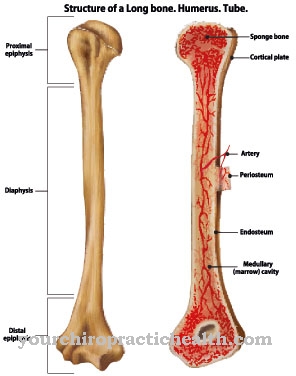The Farber's disease is a very rare metabolic disease that causes severe physical impairment and leads to death. Newborns only become ill if both parents are carriers of the same defective gene. As there is no specific therapy for the disease, it is currently incurable.
What is Farber's Disease?

© phive2015 - stock.adobe.com
Farber's disease is an incurable metabolic disease. There are several names for this disease in medicine: Farber's disease, Farber Syndrome, Ceramodase deficiency or disseminated lipogranulomatosis. Farber syndrome is named after the American pathologist Sidney Farber (1903-1973), who discovered the disease and described it.
This disease is a genetic lysosomal disease. The intracellular disruption in the lysosomes is due to a genetic defect that is responsible for the long-term storage of harmful waste in the body. Since there are only a few Farber patients worldwide, the disease is still not well understood. Patients usually die in infancy, but mostly before the age of three.
causes
Farber's disease is caused by the mutation of the ASAH gene. The mutation is transmitted in an autosomal recessive manner from the parent generation to the offspring. The ASAH gene codes for the enzymes ceramidase and acid ceramidase. However, if the gene is mutated, there is a lack of activity of ceramidase and acid ceramidase. Acid ceramidase is an enzyme that is responsible for lysosomal hydrolase.
A hydrolase is a catalysis with the participation of the enzyme ceramidase, in which the lipid ceramide is split into the amino alcohol sphingosine and fatty acid. In Farber patients this process is disturbed. In this way, the starting product, ceramide, remains undivided in the cells and is stored there for a long time. The ceramide in its original state is a waste product for the body because it cannot be processed into the necessary end product due to the genetic defect.
That is why Farber's syndrome is a metabolic disease. As a result of metabolic disorders, different complaints can occur, which differ from patient to patient. In Farber's disease, too, the point in time at which the signs of the disease appear is very different: in some patients, the first symptoms appear as early as infancy, in others, however, not until infancy. In rare cases, the disease does not make itself felt until after puberty.
You can find your medication here
➔ Medicines for painSymptoms, ailments & signs
The course of the disease is very different. When the first signs of illness appear in infancy, they usually first manifest themselves in the form of a motor disorder. Babies, for example, cannot stretch their limbs or legs and are very restricted in their movement.
The joint contractures can also cause pain that requires pain medication treatment. In addition, periarticular nodules can form in the organs or in the joints very early. Nodules that are just under the skin are also visible to the naked eye. In infants, a change in the larynx is also typical of Faber's disease.
The generic term for the larynx change is laryngomalacia. In the worst case, the change in the larynx leads to a narrowing of the airways with respiratory infections and insufficient oxygen supply, as well as to difficult food intake with growth disorders. However, short stature is a typical sign of Faber's disease regardless of laryngomalacia.
Corneal opacity and neurological abnormalities are other symptoms of Faber syndrome. It is not uncommon for the spleen and liver to enlarge. Hepatosplenomegaly is when both organs are enlarged at the same time. If the disease progresses aggressively or if diagnosis is delayed, death can occur as early as the first year of life.
diagnosis
Farber syndrome can be discovered and diagnosed very quickly. The diagnosis is made either by measuring the enzyme activity of ceramidase or by measuring the ceramide breakdown. The breakdown of ceramide takes place in the leukocytes or in cultivated skin fibroblasts. If there is any suspicion, prenatal diagnostics can also be carried out, for example if the disease is known in an ancestor.
Complications
Most cases of Farber's disease result in death. Treatment of the disease is not possible. The complications that arise in the course of the disease vary widely. However, symptoms occur in early childhood, so that patients can no longer move their limbs properly.
There are severe restrictions in everyday life. The patient is dependent on the help of other people. In many cases there is also pain, although this can be treated with the help of pain therapy. Changes to the larynx increase the risk of a respiratory infection, which can lead to death.
The short stature also occurs more intensely in Farber's disease and complicates the patient's life. The liver and spleen may also be enlarged. Treatment of the disease is not possible. In most cases, pain relievers are used to make everyday life bearable.
In the case of malformations or deformations, surgical interventions can be used, whereby the disease is alleviated. There are no further complications. Bone marrow transplantation can also reduce symptoms, but there is no complete cure for Farber's disease.
When should you go to the doctor?
Unfortunately, Farber's disease cannot be treated or prevented directly. After all, it leads to the death of the child before the child is even one year old. The doctor should be consulted if the child suffers from motor and psychological impairments. The child's movement is also significantly restricted.
Due to the severe pain, many children scream continuously and small lumps form under the skin. Medical treatment is also necessary for infections of the respiratory tract. These are noticeable in the child's breathing heavily. There is also a short stature and general disturbances of development and growth.
Farber's disease can be diagnosed by a general practitioner or by a pediatrician. However, further treatment is then carried out by various specialists. Furthermore, many parents and relatives are also dependent on psychological treatment. This can also be requested directly from a hospital. If the symptoms of Farber's disease appear acute and endanger the life of the child, an emergency doctor must be called in any case.
Doctors & therapists in your area
Treatment & Therapy
There is still no effective therapy for Farber's disease. The symptoms are treated symptomatically with painkillers and glucocorticoids. The latter inhibit inflammatory reactions and help control cell metabolism. With the help of plastic surgery, severe deformities in the body can be corrected. In this way, the symptoms are alleviated.
The treatments make life easier for patients to some extent. However, the disease progresses over time. Currently, a bone marrow transplant promises to alleviate and improve the disease. There are 50 known cases worldwide in which the bone marrow transplant was successfully performed. It is still unclear whether the procedure can cure the disease in the long term.
Outlook & forecast
Farber's disease has a very poor prognosis. The disease occurs only in very rare cases, but leads to an early death in every documented patient to date. Affected patients have parents who both have the same genetic defect. The ASAH gene has mutated in both the biological father and the biological mother.
This means that the defective gene is transferred in the womb during the development process of the unborn child. The newborn child inevitably suffers from a serious metabolic disease. The disorder is incurable due to the insufficient medical options available.
For legal reasons, researchers and scientists are currently not allowed to intervene in human genetics. This also applies to serious illnesses. Therefore, the researched and tested medicines, therapies and treatment methods are based on the patient's symptoms. Despite all efforts, there is so far no adequate medical care or alternative healing methods that lead to a reduction in the symptoms or long-term relief of existing symptoms.
Farber's disease patients die within the first few years of their lives. Since in most cases death occurs in the third year of life, it is unlikely that they will reach preschool age.
You can find your medication here
➔ Medicines for painprevention
Farber's disease cannot be prevented because the disease is inherited in an autosomal recessive manner. An autosomal recessive inheritance means that both parents must carry the mutated gene for the child to become ill. In addition, the defective allele must be on both homologous chromosomes. It is for these reasons that the disease is so rare.
And it can skip several generations until a newborn family member falls ill again. For the offspring of Faber disease patients, the probability of the disease is about 25 percent. Although the parents can pass the disease on to the children due to a genetic defect, they are usually healthy themselves.
And if only one parent carries the defective gene, your own children will remain healthy, but they can transfer the defective gene to their offspring.
Aftercare
In the follow-up care of ovarian cancer, after the therapy is completed, the focus is on the detection of a recurrence of the tumor, the monitoring and treatment of side effects of the therapy, the support of the patients with psychological and social problems as well as the improvement and maintenance of the quality of life.
After the therapy, check-ups with a gynecologist are recommended every three months. How long the controls are necessary depends on the assessment of the attending physician. Usually the gynecologist starts the check-up with a detailed discussion, whereby in addition to physical complaints, psychological, social and sexual problems are also relevant.
After that, the gynecologist usually performs a gynecological examination and an ultrasound scan. Patients who do not have any particular symptoms do not need any further special examinations. If symptoms arise over time, such as an increase in the size of the abdomen due to water retention or shortness of breath, further examinations, including CT, MRI or PET / CT, can be useful.
Complaints that occur in the course of the treatment should be taken seriously by the affected patients and discussed with the treating gynecologist. Ovarian cancer therapy often involves radical surgery. The check-ups should therefore be used to identify and treat possible consequences of the operation at an early stage. Possible side effects of necessary chemotherapy can also be monitored through regular check-ups.
You can do that yourself
Faber's disease is a very rare hereditary metabolic disorder that is considered incurable and very often leads to death in childhood. Since the disease is genetic, those affected cannot take self-help measures that have a causal effect.
Couples in whose families Faber syndrome has already occurred can seek genetic advice before starting a family. As part of this consultation, you will be informed about the likelihood that your offspring will suffer from this disorder and what stresses you have to be prepared for in this case.
Very often children with Faber's disease die as babies. The parents concerned must expect that their child will not reach the age of three. The families should not bear this enormous emotional burden alone. Relatives are recommended to consult a psychotherapist after diagnosis. Many parents also benefit from exchanges with other families in a similar situation.
Since Faber's disease is very rare, there are no specific support groups. Relatives of children with severe cancer are exposed to similar stresses. Membership in such groups can therefore be helpful in order to deal with the daily stresses and to cope better with the help of other affected persons.


.jpg)



.jpg)

















.jpg)



